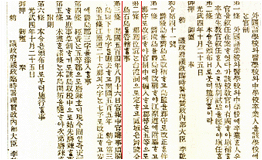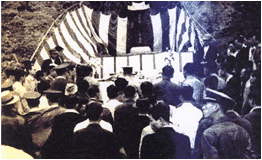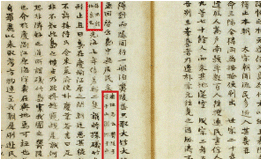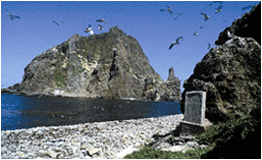I wanted to follow the status of Dokdo for you.
01
Regarding the claim that Japan has recognized Dokdo from ancient times
The claims of Japan
- Japan has been aware of the existence of Dokdo from ancient times.
- Various maps and document from Japan, such as the "Revised Non-Japanese Road Map" (1779) by Nagakubo Sekisui, one of the most representative maps of Japan showing the guide lines, confirm the fact.
Fictitiousness of the Japanese claim
 The map of East Sea coast by the Navy department of Japan
The map of East Sea coast by the Navy department of Japan(1876): The Japanese Navy marks Dokdo as belonging to Joseon Dynasty
- The "Revised Japanese Village Nohjungeon map" is a private map, and in 1779, Ulleungdo and Dokdo are pictured outside the main line of the Japan area with gray-scale like Joseon peninsular.
- Moreover, observational maps such as the "Joseon East Coast Road" (1876) of the Japanese Navy have included Dokdo in Korea's territory.
- Since the Tokugawa Shogunate regime banned Japanese fishermen from plotting Ulleungdo in 1696, the perception of the two islands became blurred and called as many names such as Matsushima, Liyangko Island, Langdo Island, Takeshima Island as well as the geographical position was completely forgotten.
02
In relation to the claim that Korea has not recognized Dokdo from ancient times
The claims of Japan
- There is no evidence that Korea has been aware of Dokdo from ancient times.
- There is no clear evidence to support that the Usando claimed by the Korean side is Dokdo, so Usando is a different name of Ulleungdo or a virtual island.
Fictitiousness of the Japanese claim
 Dokdo from Ulleungdo: Dokdo is visible from Ulleungdo.
Dokdo from Ulleungdo: Dokdo is visible from Ulleungdo.- Dokdo could be seen from Ulleungdo by the naked eye, so it could be recognized from the time people began to reside on Ulleungdo. As a result of this recognition, Dokdo is clearly written in numerous Korean observational documents such as Sejong silrokjiriji (1454), Shinjeungdonggukyeojiseungram (1530), Dongguk Munheonbigo (1770), and the mangiyoram (1808)
- Especially, Dongguk Munheonbigo (1770), and the mangiyoram (1808) indicates "Both of Usando and Ulleungdo are the land of the Usan country, and the Usan is the island that the Japanese call Songdo". Songdo is the name of Dokdo that the Japanese call at the time. Therefore, It is clear that Usando is Dokdo Island.
- A book related to the activities of An Yong-Bok, "A Written Annotation on the 9th Anniversary of the Korean Peninsula," which was found in 2005 on the island of Oki, is specified Uleungdo and Dokdo as islands attached to Gangwon-do in Korea. (Refere photo above).
- Unlike today, due to the lack of map-making techniques, there is a misrepresentation of the location or size of Dokdo in the old maps, but that is not the evidence that Dokdo was not recognized. Korea's ancient maps show that the two islands, the Ulleungdo and the Dokdo, have always been aware, especially Dokdo, whether they are private maps or official maps.
03
In relation to establishing the sovereignty of Dokdo in the middle of the 17th century
The claims of Japan
- Japan established the sovereignty of Dokdo in the middle of the 17th century at the latest by using Dokdo as a marina or a ship when crossing to Ulleungdo.
- In the early Edo era (1618), Oya and Murakawa of Tottori-shi were inhabited exclusively on Ulleungdo by obtaining a license from the Shogunate, and presented abalone to the shogunate did. Dokdo was used naturally as a navigational goal to go to Ulleungdo, as a marina on the way, and as a good fishing ground for sea lions and abalone catching.
Fictitiousness of the Japanese claim
 History of the Joseon National Foundation (1870): Document of Japanese foreign ministry reveals Ulleungdo and Dokdo as the territory of Joseon.
History of the Joseon National Foundation (1870): Document of Japanese foreign ministry reveals Ulleungdo and Dokdo as the territory of Joseon.- Traveling license is the document that does not need to travel to the domestic islands, so it proves that Japan has not recognized Ulleungdo and Dokdo as Japanese territories.
- In the middle of the 17th century, the Japanese ancient manuscript "Eunjusicheonghabgi" (1667) recorded that "the borderline of north-western Japan is Oki Islands", which proves that the Japanese themselves excluded Dokdo from their territory.
- In 1877, the Japanese government chief Tae Jeong-gwan indicates, "Based on the results of negotiations between Korea and Japan at the end of the 17th century, Both should bear in mind that Japan has nothing to do with the issue of Jukgo(Ulleungdo), and Ildo(Dokdo)”and Officially acknowledging that Dokdo is not Japanese territory.
- On the other hand, the Ministry of Foreign Affairs of Japan made a report that "Jukdo (Ulleungdo) and Songdo (Dokdo) are attached to the Joseon in the "History of the Joseon National Foundation" (1870).
04
With regards to the fact that Dokdo was not prohibited from sailing
The claims of Japan
- Japan banned sailing to the Ulleungdo port at the end of the 17th century, but did not prohibit the sailing to Dokdo.
- As a result of negotiation between Korea and Japan over sailing and fishery around Ulleungdo in 1696, the Shogunate banned the sailing of Ulleungdo, but did not prohibit the sailing to Dokdo. It is clear from that time that Japan considered Dokdo as its own territory.
Fictitiousness of the Japanese claim
 Japan's Tae Jeong-kan directive (1877): Based on the prohibition of the plotting of Ulleungdo by the Japanese Shogunate at the end of the 17th century, the national chief of the Japanese Meiji government, Tae Jeong-gwan indicated, "Keep in mind that Ulleungdo and Dokdo are not related to Japan.
Japan's Tae Jeong-kan directive (1877): Based on the prohibition of the plotting of Ulleungdo by the Japanese Shogunate at the end of the 17th century, the national chief of the Japanese Meiji government, Tae Jeong-gwan indicated, "Keep in mind that Ulleungdo and Dokdo are not related to Japan. - In response to the Edo shogunate's asked, "Is there an island attached to Jukdo (Ulleungdo) and other Tottori provinces," when the Japanese Shogunate regime prohibited the passage of Ulleungdo at the end of the 17th century, Shogunate answered that Ulleungdo and Dokdo are not belonging to Tottori.
- In addition, in the Japanese material (Oyaga) records such as 'Songdo (Dokdo) in Jukdo (Ulleungdo)' and 'Songdo near Jukdo'. As such, 'Dokdo was regarded as an island of Ulleungdo'. Therefore, in January 1696, the prohibition against navigating around Ulleungdo included the prohibition that of Dokdo as well.
- Japan 's name dispute after the prohibition was proving that Japan did not even know about Dokdo at all.
05
In relation to the contents of Ahn Yong-bok's statement
The claims of Japan
- There are many questions about the statements of Ahn Yong - bok, which Korea cites as the basis of their claims.
- Ahn Yong-bok's activities have been exaggerated in order to curtail his fault of illegal activities, which is not true because all of his record does not correspond to Japan’s.
Fictitiousness of the Japanese claim
 An Yong-bok Survey Report(1696): A document describing the activities of An Yong-bok's activities when he crossed to Japan, indicates that Jukdo (Ulleungdo) and Songdo (Dokdo) belong to Josweon, belonging to Gangwon Province.
An Yong-bok Survey Report(1696): A document describing the activities of An Yong-bok's activities when he crossed to Japan, indicates that Jukdo (Ulleungdo) and Songdo (Dokdo) belong to Josweon, belonging to Gangwon Province.- As for the Ahn Yongbok 's activities, it is difficult to accept Japan' s claim that the information is doubtful since Joseon only has the record of his activities.
- In addition, it is Japanese ignorant argument that the record is judged to be wrong because that history only existed in Joseon document.
- As a result of the activities of An Yong Bok, there was discussion about Ulleungdo / Dokdo in Japan, and as a result, two islands were recognized as Joseon territory. In response to the An Yong Bok case, the Japanese responded to the Edo shogunate's question, "It does not belong to the Tottori province," in 1695, the question was ‘when did the Ulleungdo / Dokdo belon to the Tottori clan’.
- As a result of the activities of An Yong Bok, there was discussion about Ulleungdo / Dokdo in Japan, and as a result, two islands were recognized as Joseon territory. In response to the An Yongbok case, the Japanese responded to the Edo shogunate's question, "It does not belong to the Tottori province," in 1695 when the Ulleungdo / Dokdo belonged to the Tottori clan. The prohibition of the shogunate's shoguning in January 1696 was passed on to Yonago residents in August of the same year, so Yonago residents were allowed to go to Dokdo during that period. Therefore, Ahn Yong-bok's statement that he met a Japanese in Ulleungdo in May of the same year Is not lie.
- Ahn Yong-bok's research report, "A Study on the 9th Anniversary of Joseon Dynasty," which was found in 2005 in Japan, refers to a map carried by An Yong-bok at the end of the book, In describing the name of the provinces in Korea, Ulleungdo and Dokdo belong to Gangwon Province, so it clearly demonstrates that An Yong-bok stated that Dokdo belonged to Chosun.
06
In relation with the incorporation of Shimane Province in 1905
The claims of Japan
- In 1905, the Japanese government reintroduced Dokdo into Shimane Prefecture and reaffirmed the doctrine of Dokdo.
- In April 1905, the Japanese government reaffirmed its request to establish Dokdo by Nakai Yosaburo, the 도민 of Shimane province, and the Governor of Shimane province, in February 1905, the chief officer of Shiname province notified the Dokdo that Dokdo had become a part of the Okidosha. And At the same time, it was published in newspapers and widely spread to the public.
- Japan registered the Dokdo as a license to catch sea lions, and continued to capture the them until it was stopped by the Second World War in 1941.
- It is doubtful that Dokdo, in the 1900 Imperial Korean imperial decree No. 41, was called Sukdo, and even if the question is resolved, there is no fact that Korea has effectively dominated Dokdo.
Fictitiousness of the Japanese claim
 Korean Empire Decree No. 41 (1900): The Korean Empire defines 'Seokdo' (Dokdo) as the jurisdiction of Ulleung County.
Korean Empire Decree No. 41 (1900): The Korean Empire defines 'Seokdo' (Dokdo) as the jurisdiction of Ulleung County.- The fact that Dokdo was incorporated into Japan in 1905, which is contrast to be Japan's argument that Dokdo is their own territory, If the assertion is true, then the same inclusion measures should be applied to their other territories. Reaffirming that there is a will to tolerate the territory of its own is a lame excuse not to be found in international law, and there is no such precedent.
- And the Japanese diplomatic documents from the 1950s onwards showed that the 1905 transfer was first called "pre-emptive", but later the word "reaffirmation of the will of own" was weakness of background evidence.
- In 1905, the Shimane Prefecture transfer was carried out during the Russo-Japanese War in the processes of the invasion of the Korean peninsula, and illegal and invalid measures were taken against the already established sovereignty of the Republic of Korea. Sovereignty of the Republic of Korea was so obvious to be done reorganization of administrative districts by Korean government through 41 decree of Korean Empire (1900). Therefore, the Japanese government's decision to incorporate Dokdo into Japanese area was not made in accordance with international law. It is illegal. Korea did not immediately acknowledge Japan's action and reaffirmed Dokdo as Korea's territory (1906), but only diplomatic protest was dismissed since it was deprived of diplomatic rights by the Treaty of Peace with Japan.
- Nakai Yosaburo, who submitted the petition for the inclusion of Dokdo Island, initially tried to submit a petition for lease to the ROK through the Japanese government, knowing that Dokdo was Korean territory. By the way, he was requested from the Ministry of the Navy and the Ministry of Foreign Affairs (Yamamoto Tsuyoshi, Yamazaki Nguyen) and submitted a petition to transfer Dokdo to Japanese territory. At the time, the Ministry of Internal Affairs (Inoue scribe) said, "If we incorporate a useless reef that is suspected of being a Korean land, we have a great deal of suspicion that Japan is trying to invade Korea to foreign countries that gives attention to us.
- The imperial imperial edict no. 41 of 1900 itself clearly shows evidence of Korea 's effective control over Dokdo. Considering the geographical status of Ulleungdo's surrounding islands and the life of Ulleung people who called Dok Island (Stone Island), there is no doubt that "Stone island" is Dokdo. As shown in the testimony of the 1947 pioneer of the Ulleungdo (Hong Jae-hyun) and the bombing of the Dokdo in 1948, Dokdo continued to be used as a fishery site for Ulleungdo residents both before and after 1905.
07
Regards to the actions of the post-war Allied Powers
The claims of Japan
- In the foundation process of the Treaty of San Francisco, South Korea demanded that Dokdo is one of the territories that should abandoned, but the United States rejected this demand because Dokdo was under Japanese jurisdiction. The fact that Dokdo was not included in the "Joseon", which Japan ratified its independence and abandoned all rights, rights, and claims in the Treaty of Peace with Japan in 1951, and also evident in the records of the United States.
Fictitiousness of the Japanese claim
 Map of Japan territory : Treaty of Peace with Japan (Mainichi, 1952): Immediately after the signing of the Treaty of Peace with Japan, the Japanese government also confirmed that Dokdo was excluded from Japan's jurisdiction at the time.
Map of Japan territory : Treaty of Peace with Japan (Mainichi, 1952): Immediately after the signing of the Treaty of Peace with Japan, the Japanese government also confirmed that Dokdo was excluded from Japan's jurisdiction at the time.- Initially, the United States recognized Dokdo as the territory of Korea, and the temporary change in American attitudes was made by Japanese lobby.
- It is not logical argument that it is confirmed that the territory of Dokdo which has no explicit regulation is confirmed by Japan refusing the clause which accepted the South Kuril Islands (the four northern islands) as the Russian territory in the Treaty of Peace with Japan
- The Commander - in - Chief of the United Nations applied SCAPIN No. 677 without any specific order throughout the Japanese occupation period and After the Treaty of Peace with Japan, the Japanese government also confirmed that Dokdo was excluded from Japanese jurisdiction at the time. In October 1951, the Japanese government submitted a "Japanese territorial map" to the National Assembly on the basis of the Treaty of Peace with Japan, and clearly marked Dokdo as the Korean territory.
- SCAPIN No. 677, along with Ulleungdo, defined Dokdo as an area excluded from Japanese rule. SCAPIN No. 677: 3. For the purposes of this Directive, Japan is defined as including Japan's four main borders (Hokkaido, Honshu, Kyushu and Shikoku) and some 1,000 adjacent islands. (On 1,000 adjacent small islands) ... It is excluded that ⓐ Ulleungdo • Liancourt Rocks (Dokdo) ... .
- The separation and handling of Dokdo with Japan until The Treaty of Peace with Japan after World War II was realized of the postwar policy of the Allies established by the Cairo Declaration (1943) and the Potsdam Declaration (1945). In other words, Dokdo was the territory of Korea that was abducted by violence and greed during the Russo-Japanese War, which was territorial invasion of Japan.
- Dokdo was separated from Japan by the decision of the post - war Allied Powers and was under US military rule. When the Korean government was established on Aug. 15, 1948, it was returned to Korea as one of annexed island on the Korean peninsula with all other islands. The Treaty of Peace with Japan has only confirmed this fact.
08
Regards to the military practice of the post-war Allied Powers in Dokdo area
The claims of Japan
- It is clear that Dokdo was designated as a bombing training zone of USFK in 1952 and was treated as Japanese territory. Based on the US-Japan Administrative Agreement, Dokdo was designated as one of the bombing training areas used by USFK and notified to the Ministry of Foreign Affairs.
Fictitiousness of the Japanese claim
 (June 8, 1950): In the presence of the Governor of Gyeongsangbuk-do chief officers in the Dokdo area, Korean government commemorates the unveiling of a memorial service for our fishermen who were victims of the Dokdo bombing in 1948.
(June 8, 1950): In the presence of the Governor of Gyeongsangbuk-do chief officers in the Dokdo area, Korean government commemorates the unveiling of a memorial service for our fishermen who were victims of the Dokdo bombing in 1948.- The US Air Force immediately dismissed Dokdo from the bombing training area in response to South Korea 's protest and officially informed the Korean. The facts that Dokdo was located in Korea's air defense identification area (KADIZ) and was outside the Japan Air Defense Identification Area (JADIZ), confirm that both government admitted that Dokdo was a Korean territory.
- Despite the damage of our residents who were working in Dokdo, Dokdo was designated as a bombing practice site, and it is easy to check that the repeated the military practice done in Dokdo area in 1952 was the result of Japanese governmental instruction through the contents of remarks made by the Japanese parliament.
- The following is the remarks made by a Yamamoto, a congressman of Shinema province, and Ishihara vice-minister of Foreign Affairs of Japan at 중의원 외무위원회 on May 23, 1952. Yamamoto and Deputy Foreign Minister Ishihara. Yamamoto: "Please tell us about the point that the Ministry of Foreign Affairs wants to designate a practice site in the sense that it is easy to confirm the territorial right of Japan in Dokdo area when the Dokdo is designated as a practice place". Ishihara vice-minister answered "It seems to be promoting variously in such an idea generally."
09
Relation to the effective domination of Dokdo by Korea
The claims of Japan
- Korea is illegally taking over Dokdo, and Japan complained about that in a serious manner. The occupation of Dokdo by Korea is an illegal without any grounds in international law, and there is no legitimate right for any measure taken by Korea in Dokdo.
Fictitiousness of the Japanese claim
 Mangiyoram (1808): 'Ulleungdo and Usando (Dokdo) are both territories of Usan country'.
Mangiyoram (1808): 'Ulleungdo and Usando (Dokdo) are both territories of Usan country'.- Japan has never established sovereignty over Dokdo at any time, and Japan's claim is merely a one-sided, illegal act that infringes on the territorial sovereignty of the Republic of Korea over Dokdo.
- It was in 1905 that Japan intended to secure the sovereignty over Dokdo, and Republic of Korea had already established its sovereignty over Dokdo. In Korean governmental document such as 만기요람 1808, 세종실록지리지 1545, and Daehan Imperial decree in 1900, and some Japaneses governmental document such as 도해금지령 of Edo Shogunate in 1696, and the 조선국교제시말내탐서 of the Meiji government In 1870, the Taejeongbuk Order in 1877 and others like SCAPIN No. 677, and No. 1033 (Official Official Document of the Allied Nations Command) in 1946 clarify that Dokdo is Korea's territory.
10
Relating to the suggestion of Japan to take this issue to the International Court of Justice
The claims of Japan
- Japan has proposed to refer the case to the International Court of Justice on the issue of the territorial rights of Dokdo, but South Korea is refusing to do so. In September 1954, the Japanese government proposed the referral to the International Court of Justice in March 1962, but the Korean side rejected it.
Fictitiousness of the Japanese claim
 The Future-Oriented Relationship between Korea and Japan, Dokdo
The Future-Oriented Relationship between Korea and Japan, Dokdo- Japan has a contradictory attitude denying refer Dokdo issue to the International Court of Justice but only refer to Jodo Island (Senkaku Islands) or the South Kuril Islands (the four northern islands) issues to the ICJ.
- Dokdo is the land of history that was regained after the invasion of the Korean peninsula by Japanese imperialism. Dokdo clearly, is a territory of the Republic of Korea and there is no reason to refer it to the ICJ. It is only desirable for Japan to stop claiming Dokdo islands based on their history of imperialism.